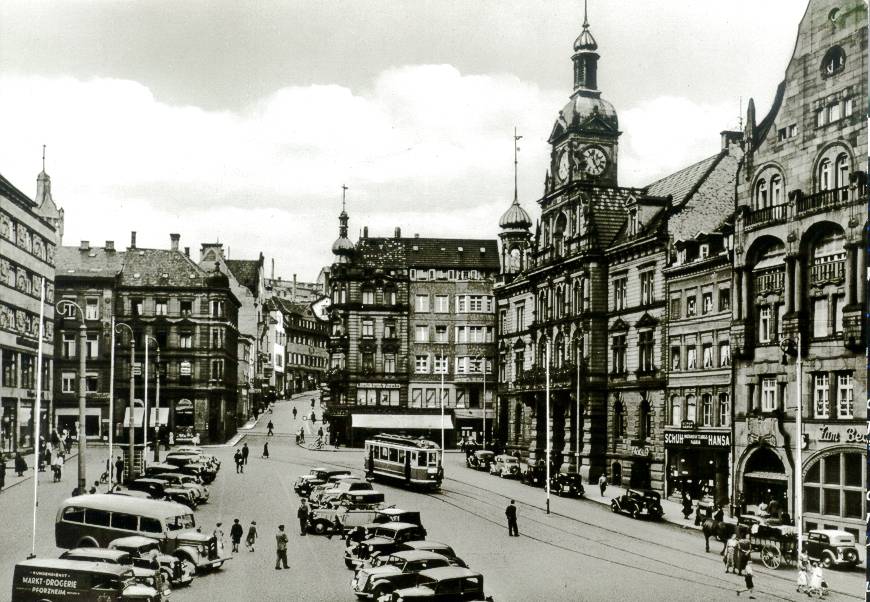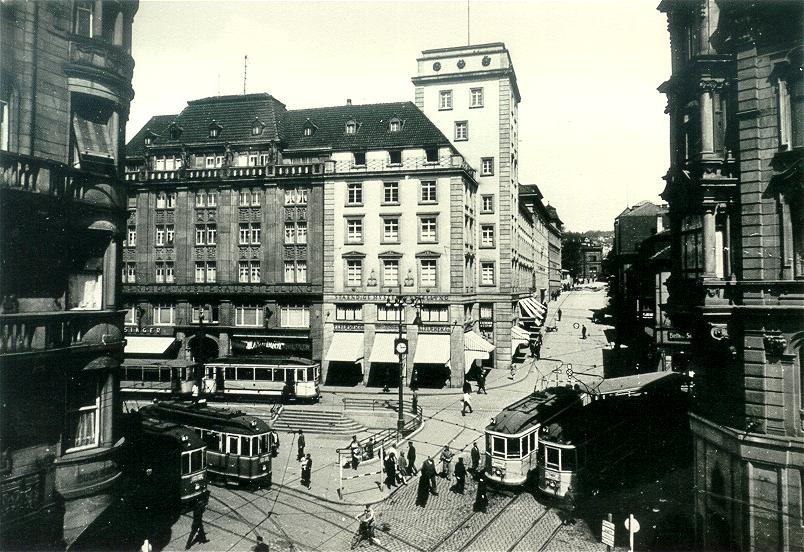YELLOWFIN ...
... is a species of tuna fish found in tropical oceans - and it was the target
codename of the British Royal Air Force for my hometown PFORZHEIM. On February
23, 1945 - only a few weeks before the end of World War II - one of the most
terrible and absurd bombing raids wiped it out within only 22 minutes. In terms
of those killed as a percentage of the total population and of the area devastated
as a percentage of the total city area, Pforzheim suffered more than any other
town in Germany and even more than Hiroshima. This unjustified indiscriminate
area bombing was the brainchild of "Bomber Harris", known for his terror attacks
on German cities.
On this page you can discover what happened back then. The Video "A City
Dies !" is an excerpt from the Universal Newsreel 18-381 of March 15, 1945.
"Bombing of Pforzheim in World War II" are excerpts from a Wikipedia
article which reports just the facts. "A Lesser Dresden" is an emotional
but still factual feature article by an unknown author, a good expression of my
own and probably of many Pforzheimers' feelings. This page is a tribute to my
once beautiful hometown PFORZHEIM, which had been reduced to a mass grave and
to rubble, but which resurrected from its ruins ...
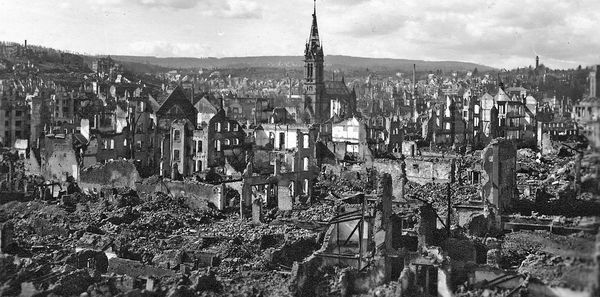
A City Dies !
"Air warfare, terrifying and devastating, has returned one hundred fold to
Germany. RAF Lancasters unload everything from 500-pounders to block-busters
on Pforzheim, important industrial center. A city is literally being wiped out
before your eyes. Explosions and fires are sucking the oxygen from the air,
nothing can live in this inferno. City by city the Nazireich is dying ..."
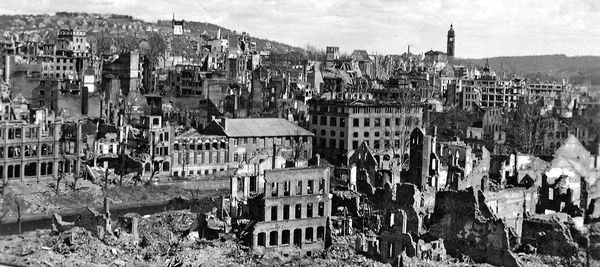
Bombing of Pforzheim in World War II
excerpts from the Wikipedia article as per February 23, 2010
During the latter stages of World War II, Pforzheim, a town in southwestern Germany, was bombed a number of times. The largest raid, and one of the most devastating area bombardments of the war was carried out by the Royal Air Force (RAF) on the evening of February 23, 1945. 31,4% of the town's population, up to 17,600 people, were killed in the air raid. About 83% of the town's buildings were destroyed, two-thirds of the complete area of Pforzheim and between 80 and 100% of the inner city ...A report compiled for RAF Bomber Command dated 28 June 1944, stated that Pforzheim was "one of the centres of the German jewellery and watch making trade and is therefore likely to have become of considerable importance to the production of precision instruments [of use in the war effort]." An Allied report issued in August 1944 stated that "almost every house in this town centre is a small workshop" and that there were a few larger factories in the south and one in the north of the city centre. An attack on the city would destroy the "built-up area, the associated industries and rail facilities". There were no war-crucial targets only war-relevant ones.
In November 1944, Pforzheim was placed for the first time on a target list of the Allied Forces, but with the lowest priority of category five. In that report the city was described as being very suitable for a raid, because the road and rail communications through the old city was known to be very flammable. Pforzheim was used in the transfer of troops.
Detlef Siebert wrote for the BBC History website "Some of them, like Würzburg or Pforzheim, were selected primarily because they were easy for the bombers to find and destroy. Because they had a medieval centre, they were expected to be particularly vulnerable to fire attack.
The large raid that almost completely destroyed the inner city district occurred on the evening of February 23, 1945. The first bombs were dropped at 19:50 and the last one at 20:12. The attack on "Yellowfin", the code name for Pforzheim, included 379 aircraft.
The bombers were 367 Avro Lancasters of No. 1, No. 6, and No. 8 groups along with, one Film Unit Lancaster, and 13 Mosquitos of No. 8 Group. The master bomber was Major Edwin Swales, DFC a South African, aged 29, who won Bomber Command's last Victoria Cross of the war for his actions on this night. Despite severe damage to his plane he remained over the target for the whole of the raid but he was killed when his Lancaster crashed in Belgium on the return flight.
The bomber stream attacked from a height of 8,000 feet (2,400 m). It dropped almost half a million bombs with a total weight of 1,825 tonnes. The bombs were a by now standard mix of high explosive and phosphorus incendiary bombs. The core area of the town suffered immediate destruction and a firestorm broke out, reaching its most devastating phase about 10 minutes from the start of the raid. The smoke over the town rose to about 3,000 meters, and the returning bomber crews could still see the glare of the fire up to 160 kilometers away ...
The German Army Report of February 24, 1945 devoted only two lines to reporting the bombardment: "In the early evening hours of February 23, a forceful British attack was directed at Pforzheim". The post-war British Bombing Survey Unit estimated that 83 per cent of the town's built-up area was destroyed, "probably the greatest proportion in one raid during the war".
In an area about 3 kilometers long and 1.5 kilometers wide, all buildings were reduced to rubble. 17,600 citizens were officially counted as dead and thousands were injured. People died from the immediate impact of explosions, from burns due to burning phosphorus materials that seeped through basement windows into the cellars of houses where they hid, from lack of oxygen and poisonous gases, and from collapsing walls of houses. Some of them drowned in the Enz or Nagold rivers into which they had jumped while trying to escape from the burning phosphorus materials in the streets, but even the rivers were burning as the phosphorus floated on the water.
After the attack, about 30,000 people had to be fed by makeshift public kitchens because their housing had been destroyed. Almost 90% of the buildings in the core city area had been destroyed. Many Pforzheim citizens were buried in common graves at Pforzheim's main cemetery because they could not be identified. There are many graves of complete families ...
The inner city districts were almost totally depopulated. According to the State Statistics Bureau (Statistisches Landesamt), in the Market Square area (Marktplatzviertel) in 1939 there were 4,112 registered inhabitants, in 1945 none (0). In the Old Town area (Altstadtviertel) in 1939 there were 5,109 inhabitants, in 1945 only 2 persons were still living there. In the Leopold Square area, in 1939 there were 4,416 inhabitants, in 1945 only 13 ...
Rather than rebuild the centre of Pforzheim on the old street plan, the main thoroughfares were widened after the war. The rubble from the destruction was heaped into a large, high mound on the outskirts of the town and covered with soil and vegetation. It is officially named the "Wallberg". As with other German cities which have similar mounds, it remains a visible reminder of the destruction visited on the city during World War II ...
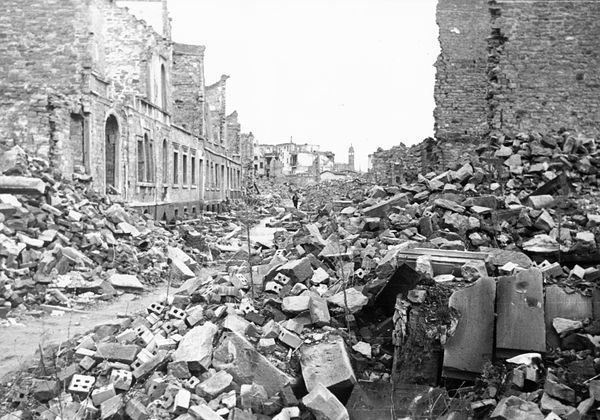
A Lesser Dresden
by an unknown Author
Atrocities are relative. In the case of one bombed town which receives little mention, the bombing was every bit as cataclysmic as that of Dresden in that a full third of its population was wiped out in one hellish hour. No, there are no parades or demonstrations in remembrance of the event, there is only a mountain in the distance which looks eerily similar to those near almost every German city. It is where their past is buried, where the burned, scarred rubble of an incinerated town was dumped and covered with dirt which has long since grown grass and trees.No, Pforzheim isn't Dresden. In fact, it was one of the smaller towns in Baden. This sleepy place, with a charming medieval center, was only about the size of Concord, New Hampshire, and did not even come close to being an "industrial" center. It was just a quiet hamlet on the edge of the Black Forest, once even called the "Paris of the Black Forest" because of its antique charm and age-old tradition of jewelry and clock making, mostly cuckoo clocks. Therefore, there was absolute shock the first couple of times it was targeted for bombing.
The first surprise Allied air raid by Americans was reported to be the result of bombers "missing their mark" on some other target, and it took place over the city April 1, 1944 killing 95 civilians. The true horror would come later. Based on a vague RAF bomber command report of June, 1944 which insinuated that Pforzheim was "one of the centers of the German jewelry and watch making trade and is therefore likely to have become of considerable importance into the production of precision instruments" and an Allied report issued in August, 1944 which continued to expand this rumor without any further evidence ("almost every house in this town center is a small workshop"), an attack on the city was suggested to destroy the "built-up area" (meaning the civilian residential center of town) and, secondarily, "the associated industries and rail facilities". So again, On October 3, October 4 and October 5, 1944 there were raids and another three in October and one in November. On Christmas Eve, 1944 and on January 21,1945 there were even more raids and another 56 civilians died (the Christmas Eve raid killed a dangerous contingent of caroling children).
The cataclysmic attack on the small medieval city center came on the evening of February 23, 1945 with the first bombs dropped at 8 pm and the last at a little past 9 pm. It was relatively easy at that point in the war with Germany's defenses all but absent. The ridiculously overzealous attack included 379 aircraft that attacked old Pforzheim from a height of 8,000 feet, dropping a half a million high explosive and phosphorus incendiary bombs with a weight of 1,825 tons right smack in the middle of town. A firestorm immediately enveloped the heart of Pforzheim and its bombed gas works added fuel to the fire.
In one dreadful hour, 17,600 citizens, or one out of three Pforzheimers, were officially counted as dead and thousands were hideously injured, some from the actual explosions and many from burns due to the burning phosphorus that seeped into the cellars of houses where they hid. Still others died slowly but painfully from suffocation due to lack of oxygen and poisonous gases, and others from being crushed to death by collapsing walls.
The napalm-like phosphorous bombs (with the phosphorus supplied by America and used by the British against German civilians) formed a burning gel which cannot be extinguished by ordinary means. It caused massive burns while its victims slowly perished in agony. If it landed on the hair, the whole head caught fire. People in these attacks were seen running like human torches until they mercifully expired. Materials thrown over the burning victim to smother the fire actually caught fire themselves, adding just another layer of flame. Many of the people drowned in the rivers into which they had jumped, trying in vain to escape from the burning materials in the streets, but even the rivers were burning as the phosphorous material floated on the water. Water, which puts out normal fires, doesn't work, as the gel reignites instantly when the affected body part reemerges from the water. Therefore, the victims who ran to the river faced a choice between drowning or burning to death, and many drowned themselves and/or their burning children to end the suffering quickly. Witnesses were so deeply shaken they could barely speak of what they had seen.
The attack on Pforzheim left 30,000 stunned, frantic, grieving and half-insane survivors, many horribly injured, who had to be taken care of, but their facilities were all gone. 90% of the buildings in the city center had been utterly destroyed. Many citizens were buried in mass graves at the main cemetery because they were burned beyond recognition. As in other fire-bombings, whole families were found huddled together, melted into a single black, oozing pile. In the days following the attack, many more died in great pain from their injuries. There were numerous suicides of people who lost all of their loved ones. The very old, the very young and women were the primary victims. The inner city was completely depopulated by this purely civilian attack. But even that was not enough, and there were additional attacks on Pforzheim. On March 4, a US plane flew low and opened fire on a crowd of surviving citizens, murdering 100 more people in cold blood.
More shocking, it was not until March 14, 16, 18, 19, 20 and 24, that the railway facilities were bombed and a vital local section of the Autobahn was destroyed! So, even if it were true ( and it was never proved ) that "nearly every house" was making fuses for bombs, simply taking out the railroad and highways in and out of the city would have been enough to stop such activity without the massive carnage and utterly inhumane infliction of terror and death. And furthermore, even if it were true that "nearly every house" was making fuses for bombs, certainly the thousands of dead children of Pforzheim were not. But if people thought like that, we would have no heroes.
The post-war British Bombing Survey Unit boasted that the bombing destruction of Pforzheim was "probably the greatest proportion in one raid during the war." Yet, it is interesting that even though some Dresden apologists and garden variety conformist historians now tend to cite the assault on Pforzheim as unnecessary overkill and perhaps even a criminal bombing, it still gets no press, no visits from the English queen, no songs written in its honor. It just sleeps under its mountain of soil with its dead children at its feet.
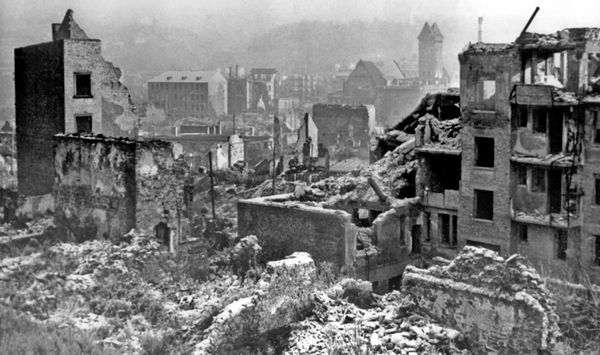
... and finally, two pictures of old Pforzheim before its devastation:
